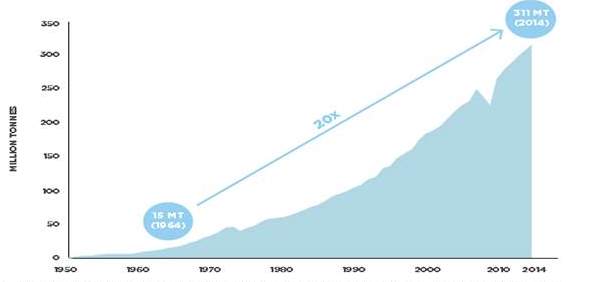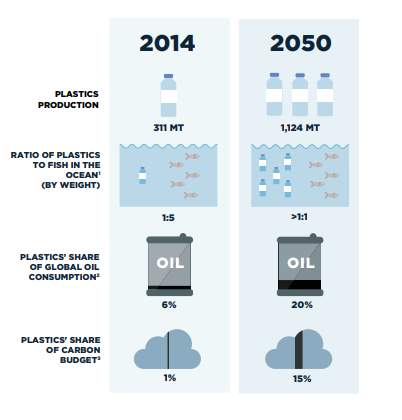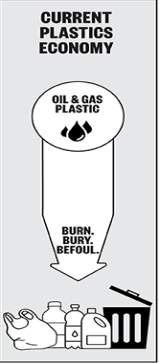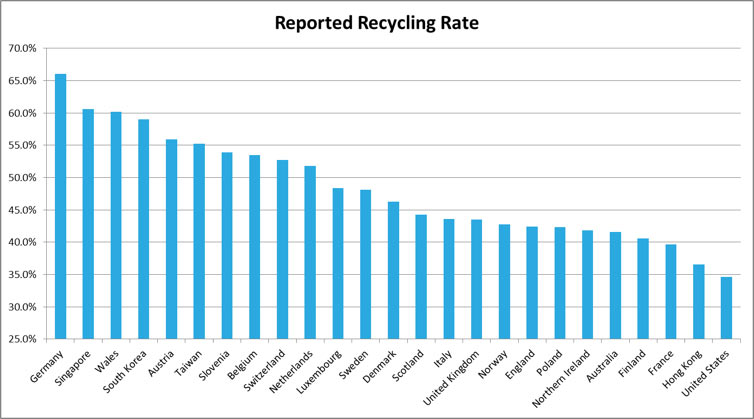Negative Impacts of Plastic Pollution on World Economy
| ✅ Paper Type: Free Essay | ✅ Subject: Environmental Studies |
| ✅ Wordcount: 1763 words | ✅ Published: 03 Nov 2020 |
Introduction and Economic problem
Since its invention, plastic has been and still is vital to global development. Plastics have been a straight-line trajectory of growth and prosperity – injecting immense amounts of fortune into the global economy. More than a century later and plastics still have endless possibilities. Today, more than half the weighti of the Boeing Dreamliner 787 – whaich is one of the most advanced planes – is comprised of plastic. The digital revolutioni that introduced the informationi age is driven by bitsi and bytes housed in plastic. Through contact lenses and prosthetics, plastics have even gifted people with sight and limbs. It is of no doubt that plastic has been the key component for sectors as diverse as packaging, construction, healthcare and electronics. However, through human exploitation and ignorance, plastics have had severe and dire consequences. These negative impacts of plastics are becoming more apparent by the day.
Plastic production has surged over the past 50 years, from 15 million tonnes in 1964 to 311 million tonnes in 2014 (Ellen Macarthur, 2016). Due to improper disposal of these plastics, approximately 8 million pieces of plastic end up in the oceans every day. It is predicted that there may now be around 5.25 trillion macro and microplastic pieces floating in the ocean (Surfers Against Sewage, 2019). These figures are bound to increase to such an extent that by 2050, there will be more plastic in the ocean than fish. Not only is this affecting the ecosystem, but it also has had severe impact on the economy. Plastic pollutioni has negatively affected the wellbeingi of different sectors of the economy such as; fisheries, agriculturei and recreational/ tourism activities. This has caused a global decline of 5% in the benefitsi that humansi derive from oceans – costing the global economy $2.5 trillion every year (Hodal, 2019).

(Parliament of Australia, 2019)
Figure 1 Growth in Global Plastic Production
Causes and effects
Negative externalities of production
The high degree of household and industrial improper disposal of plastic, with conjunction to the fact that plastic is not easily degradable, has created negative externalities of significant proportions. These externalities include; deterioration of natural systems as a result of Ieakage, especiaIIy in the ocean; greenhouse gasses resulting from productioni and after use incinerationi; health and environmental impacts from substances of concerni (Hughes, 2019). Two examples of the undesirable effects from inadequate disposal of plastic waste are; the environmental damage caused by landfills and toxic emissions arising from incineration (Mario, 2008). These externalities result from the failure to internalize costs associated with inefficient recycling. This then causes the marginal social cost to be greater than the marginal private cost. Refer to figure 2 below.

(Riley, 2018)
Figure 2 Negative externalities of production
Effects
The inefficient recycling creates a serious aestheticn quandary in urbanizedi areas of the world. The chemical stability of plastic obviates plastic waste from decomposing at a rate commensurable to the rate of waste generation. As plastic waste accumulates, damages will elevate, and the economy will be negatively impacted. These damages include the quantifiedi market and nonmarkets (Abbott, 2019)welfarei effects of plastics throughi their effectsi on population of harvesteds mariney species and species with significant conservationi value (Frontiers in Marine Science, 2019) E.g. the great barrier reef is considered a natural treasure of Australia. It injects $6.4 billion to the economy every year through tourism (Perry, 2017) and currently supports 64000 (The Project Staff, 2019) jobs in Queensland. However, as plastic waste has been damaging the coral at an alarming rate, this $6.4 billion will be lost and 64000 jobs will be at risk. Loss of these jobs will then go against the economic objectives by increasing unemployment hence lowering the standard of living. If production and use continue within the current lineari framework, these negative externalities will be exacerbatedi, as laid out in figure 3 below.

(Ellen Macarthur, 2016)
Figure 3 Effects of plastic pollution in the future
Market Failure
The major market failure from inefficient plastic disposal is the waste in materials and resources resultingi from the relativelyi low recycling rate of 25%. This low plastic recycling rate implicatively insinuates that the great majority of polymer-based materials utilizedi for plastic products enter the waste streami never to be used again. This broadens the issue as there is diminutive value placed on such a versatilei material made from a finiteo resource – whose environmental legacyi lasts decades after its ibrief use. This is a result of the current linear economic model of plastic production as shown in figure 4 below.
 In this model, raw materials are processed into a product and thrown away straight after use – which wastes the finite resources that are available and is not an ecological sustainable development.
In this model, raw materials are processed into a product and thrown away straight after use – which wastes the finite resources that are available and is not an ecological sustainable development.
(Research Gate, 2019)
Figure 4 Current linear plastic economy.
Solutions
The US$ 2.2 trillion (Frontiers in Marine Science, 2019) annual externali cost of plastic pollutioni is not reflected in the production costs of the lineari plastics economy, indicating a major market failure. Although measures such as Extendeds Producer Responsibility (EPR) and plastics-related legislationi (Frontiers in Marine Science, 2019)have made some positive steps towards reducing plastic pollution, a system-vast change is requiredi to rectify this market failure. A pragmatici solution would be a government-based contribution, whereby consumers are offered incentives (cashback) for properly recycling the plastic. The supply chainl will pass on this pricei premium on rawi plastic resini equitably through to the trillions of plastic items purchasedi each year by end consumers, convertingi plastic waste into a cashable commodityi. In coherence to this, the government should also start properly funded recycling program. This then has the greatest potential to drive global manufacturing toward a circular economy. Refer to figure 5 below
 (Research Gate, 2019) Figure 5 Circular plastic economy
(Research Gate, 2019) Figure 5 Circular plastic economy
A number of countries today apply these strategies and have acquired positive results. These countries include Germany, Austria and South Korea – the world’s leading recyclers (Resource, 2017)

Figure 6 Graph to show the percentage of countries’ recycling.
Alternative Solution
The government can also create certain regulations, taxes and bans on plastics. Taxing plastics will increase the private costs of producers and encourage them to innovate and find new ways of reducing the amount of plastic used in the products. Taxing plastic producers will ensure that the external costs are internalised. Unless the producers find new ways of reducing the plastic content, their costs will rise, and their profits will fall. Although in theory taxing plastic will help correct the market failure, in practice it may not as producers will pass the tax onto the consumer by increasing the cost.
Evaluation table
|
Solution 1 |
Solution 2 |
|
|
Employment |
|
|
|
Standard of Living |
|
|
|
Economic Growth |
|
|
Assessing the solutions with the above criteria, the best solution would appear to be solution one; which is incentives and proper funding to start recycling programmes. It will create new jobs; better standard of living and economic growth. With that said; it would be better to implement both solutions as it will balance the positives and negatives of each solution. The revenue gained from the increased tax of producers can be used to initiate the incentives and recycling programmes. If producers decide to cut labourers, new jobs will be provided by solution one. If producers pass the taxes to consumers by increasing cost, the incentives can be used to cover for the higher prices.
Conclusion
Plastic has been beneficiary to the economic development. However, due to improper disposal, plastic pollution is a threat to the global economy. If this issue is not addressed, it will damage the economy. Therefore, it is recommended that both the above solutions are implemented simultaneously to acquire the best results.
References
Bibliography
- Abbott, J. K. (2019). Reducing Marine Plastic Pollution: Policy Insights from Economics. Review of Environmental Economics and Policy, 327-336.
- Ellen Macarthur. (2016). The new Plastic economy. Retrieved from ellenmacarthurfoundation: https://www.ellenmacarthurfoundation.org/assets/downloads/EllenMacArthurFoundation_TheNewPlasticsEconomy_Pages.pdf
- Frontiers in Marine Science. (2019, September 25). Eliminating Plastic Pollution: How a Voluntary Contribution From Industry Will Drive the Circular Plastics Economy. Retrieved from Frontiers In: https://www.frontiersin.org/articles/10.3389/fmars.2019.00627/full
- Hodal, K. (2019, April 4). Marine plastic pollution costs the world up to $2.5tn a year, researchers find. Retrieved from The Guardian: https://www.theguardian.com/global-development/2019/apr/04/marine-plastic-pollution-costs-the-world-up-to-25bn-a-year-researchers-find
- Hughes, K. (2019, September 24). 3 Ways we are making an impact on plastic pollution. Retrieved from World Economic Forum: https://www.weforum.org/agenda/2019/09/we-created-an-initiative-to-fight-plastic-waste-here-are-3-takeaways-from-our-first-year/
- Mario, F. (2008, November 2). Plastic Materials and Environmental Externalities: Structural Causes and Corrective Policy. Retrieved from ethbridge Undergraduate Research Journal: https://lurj.org/issues/volume-3-number-2/plastic
- Parliament of Australia. (2019). Overview of Marine Plastic Pollution. Retrieved from Parliament of Australia: https://www.aph.gov.au/Parliamentary_Business/Committees/Senate/Environment_and_Communications/Marine_plastics/Report/c02
- Perry, N. (2017, June 29). What’s the economic value of the Great Barrier Reef? It’s priceless. Retrieved from The conversation: https://theconversation.com/whats-the-economic-value-of-the-great-barrier-reef-its-priceless-80061
- Press Association. (2010, September 14). Increased recycling could create 50,000 jobs, report finds. Retrieved from The Guardian: https://www.theguardian.com/environment/2010/sep/14/recycling-jobs-england
- Research Gate. (2019). Retrieved from Researchgate.net: https://www.researchgate.net/figure/Illustrations-of-the-linear-plastics-economy-left-circular-polymers-economy-right_fig2_336022942
- Resource. (2017, March 13). RECYCLING: WHO REALLY LEADS THE WORLD? Retrieved from Resource.co: https://resource.co/article/recycling-who-really-leads-world-11739
- Riley, G. (2018). Negative Externalities. Retrieved from Tutor2u: https://www.tutor2u.net/economics/reference/negative-externalities
- Surfers Against Sewage. (2019). Plastic Pollution Facts and figures. Retrieved from Surfers Against Sewage: https://www.sas.org.uk/our-work/plastic-pollution/plastic-pollution-facts-figures/
- The Project Staff. (2019, September 24). Cairns And Townsville Become ‘Plastic Free Places’ To Try Save The Reef. Retrieved from 10daily: https://10daily.com.au/shows/theproject/exclusive/a190924sqatg/cairns-and-townsville-become-plastic-free-places-to-try-to-save-the-reef-20190924?sfns=mo
Cite This Work
To export a reference to this article please select a referencing stye below:
Related Services
View allDMCA / Removal Request
If you are the original writer of this essay and no longer wish to have your work published on UKEssays.com then please click the following link to email our support team:
Request essay removal



